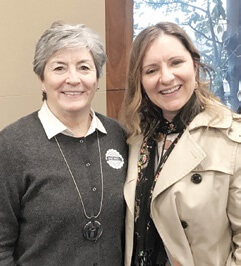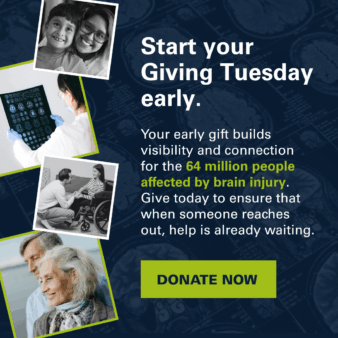From Patient to Advocate: The Story of Ten Years at Brain Injury Awareness Day
Categories: Living with Brain Injury, Public Policy
By Angela Leigh Tucker, Member, Brain Injury Association Advisory Council
Eight months after surviving a life-changing car crash and at a time when people were unsure if I would ever be able to walk again, I made it all the way to the steps of Capitol Hill in Washington, D.C. for the 2009 Brain Injury Awareness Day. Last year marked the tenth time I attended Awareness Day and in honor of that, I want to examine the impact this event has made on my healing journey.
Writing this was an exercise in concentration and to help fill in my gaps in memory. I reviewed old photos that were stored in my iPhone and sifted through old travel timelines and documents I created called “Lessons Learned,” a habit I developed over my years in public relations. Fifteen years ago, I had no way of knowing that this skill would later become a helpful tool in my recovery from brain injury that would aid me in being able to remember past events and look forward to future planning.
While reviewing these old notes, here are some important lessons I learned during my adventures:
- Establish a Capitol Hill Buddy – a travel companion who will make sure you don’t get lost or lose track of time.
- Print out the names of people who you schedule meetings with, including time and location of appointments.
- Pack snacks and remember to bring cellphone charger.
- Date and make personal notes on the back of each business card you collect to help remember each person.
- Print extra copies of Capitol Hill and D.C. maps for those who may need them.
- Practice mindful alcohol consumption during the Congressional Brain Injury Task Force Awareness Day Reception.
- Don’t wear the shoes with the gold buckle because they are very uncomfortable! And don’t wear the gold blouse again; it reveals too much cleavage!

BIAA President/CEO Susan H. Connors and Angela Leigh Tucker celebrate at the 2018 Brain Injury Awareness Day reception.
My dear friend Karen Keating from the Brain Injury Association of North Carolina introduced me and my father to this important national event, which has since become one of the highlights of my year. I cannot recall many of the details from my first trip. I was still wearing a hard neck-collar to protect a healing C1 vertebrae, so my friend, Claire, helped me get dressed in my business suit to meet with my North Carolina representatives. Claire lives and works in the D.C. area and ever since that first trip has continued to generously open her home to me so that I may attend each year. Brain Injury Awareness Day occasionally falls on my birthday, and Claire has definitely served me a slice of birthday cake more than once.
In 2009, I was safely guided by Karen, who booked all the appointments for me. I vaguely recall being led to a chair in an office where I would simply answer questions. I have no way of knowing how my answers may have influenced change. I don’t remember whether I felt self-conscious about the neck brace or about the fact that I needed someone to lead me everywhere. Regardless of this, I felt like an expert in that moment and that had a profound and lasting effect on me. That initial energy is why I continue to advocate today.
So many “versions” of me have visited D.C., and somewhere along the way I experienced a shift from arriving as a patient to showing up as an advocate. But that shift did not happen overnight and was not without a lot of bumps along the way. Prior to the accident, I travelled often for my job and was a skilled navigator. After the accident, as a TBI survivor, I learned traveling would be challenging. I believe it was during my 2011 trip to D.C. that I left all of my important travel documents in a folder at home. I didn’t realize this until I reached Penn Station in midtown Manhattan and had no choice but to return to my apartment on the Upper West Side. The pressure to get there and back in time was enormous.
I always plan for big trips like this for weeks in advance in order to feel safe. My bag was packed, and I had prepared a folder with my travel itineraries, D.C. maps, and train ticket. I remembered my bag, but the folder was still sitting on my dining room table. Maybe other survivors can relate? In order to prevent this scenario in the future, I developed a strategy that I still use today. I leave all important travel documents on the floor in front of my front door (no more table) so I literally cannot walk out of the house without them.
While some years have been a little stressful, others have brought new friends and great connections. In 2013, I met a survivor from Pennsylvania in a most unexpected way: while I was standing in a bathroom line in the Rayburn Building. I guess I was eavesdropping on the two beautiful women in front of me, because I interrupted during a break in their conversation.
“Excuse me,” I said. I have never been a shy person and I had not yet re-developed my brain’s filter, “Are you survivors?”
The brunette standing closest to me nodded. I smiled and arrogantly responded, “Wow! We make brain injury look good!” She introduced herself as Angie Ficco. Angie invited me to attend her state’s annual conference two months later, and we have remained close friends ever since. One of my favorite parts about attending this event is being able to meet incredible people who travel from across the nation to share their stories of survival.
As I gained experience and continued cognitive remediation therapy, I began to help others living with brain injury attend this event. I introduced Brain Injury Awareness Day to members of a New York City TBI support group I attended. With the news and enthusiasm I shared, the NY delegation attended the event each year and grew from one or two people to a formidable force of ten eager advocates! It’s exhilarating to be part of this purpose-driven troop on Capitol Hill.
I always organize a celebration dinner at a casual Mexican restaurant nearby called Tortilla Coast as a nice way to finish the day. While noshing on tacos and laughing over margaritas, it isn’t long before many of us are faced with a condition called neuro-fatigue. I experience it as an overwhelming exhaustion unlike any other. I will yawn, slur my words, and become unable to focus my eyes. My husband often recognizes it’s happening before I do. The only remedy I have discovered is immediate sleep. For this reason and to combat crashing during appointments, I try to carve out a short nap or break somewhere during the day full of action.
Brain Injury Awareness Day provides an opportunity for people to learn about research, prevention, rehabilitation, and community services within the world of brain injury. It is also an opportunity to meet with political leaders who are potential advocates within our community. Hundreds of survivors, families, friends, and professionals attend to raise awareness of the many ways brain injury visibly and invisibly impacts members of our community and society in general. During the event, there is an Awareness Fair that is designed to bring people together so that federal and national organizations can network among state peers and leaders.
I recognize all the growth that has transpired during my transition from patient to advocate, and I will continue to encourage my members of Congress to join the Congressional Brain Injury Task Force. Due to brain injury, my life and millions of other lives are forever changed. Because there will always be new discoveries, treatments, and services, I will continue to attend Brain Injury Awareness Day. There will always be wonderful new friends to meet who are traveling their own healing journey. While no two recoveries will ever look the same, there is something tremendously therapeutic about not traveling the path of healing alone.
This article originally appeared in Volume 14, Issue 1 of THE Challenge! published in 2020.

